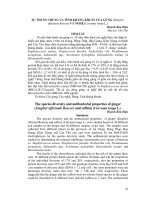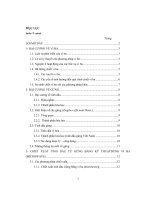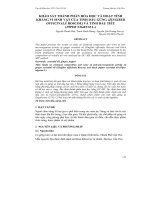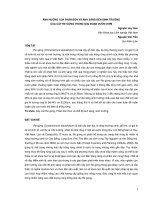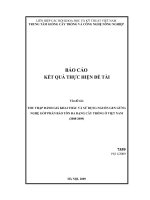Gừng gừng
Bạn đang xem bản rút gọn của tài liệu. Xem và tải ngay bản đầy đủ của tài liệu tại đây (241.48 KB, 6 trang )
<span class="text_page_counter">Trang 1</span><div class="page_container" data-page="1">
<i>DOI: 10.22144/ctu.jen.2022.044 </i>
<i><b>The antimicrobial activity and chemical composition of Elsholtzia blanda (Benth.) </b></i>
<b>Benth. essential oils in Lam Dong Province, Viet Nam </b>
Nguyen Van Ngoc<sup>*</sup>, and Hoang Thi Binh
<i>Faculty of Biology, Dalat University, Viet Nam </i>
<i>*Correspondence: Nguyen Van Ngoc (email: ) </i>
<i>Received 30 May 2022 Revised 28 Jun 2022 Accepted 31 Aug 2022</i>
<i>This study aimed to assess the chemical composition of essential oils of Elsholtzia blanda (Benth.) Benth. in Lam Dong Province, Viet Nam, and evaluate their biological activities. Essential oils obtained by hydro-distillation of the aerial parts of E. blanda were analyzed by gas chromatography-mass spectrometry (GC-MS). Thirty-one constituents were identified in the oil, and the essential oil was predominantly monoterpenoid, with camphor (25.14%), camphene (22.64%), -Pinene (11.53%), and cineole (9.89%) as the four most abundant constituents. The evaluation of antimicrobial activity using the agar wells diffusion method showed that the essential oil in all concentrations was active against the Gram-positive bacteria (Staphylococcus aureus), Gram-negative bacteria (Escherichia coli), and pathogenic yeast (Candida albicans), they are most sensitive and resistant to S. aureus strain. </i>
<i>The genus Elsholtzia Willd. belongs to the family </i>
Lamiaceae (Bestmann et al., 1992; Raven & Hong, 1994; Guo et al., 2012). It is composed of about 40 species, distributed in East Asia, Africa, North America, and European countries, and is especially prevalent in China, Korea, Japan, and India (Haiyun et al., 2004; Guo et al., 2012). The plants in the genus are mostly aromatic plants and have been used in traditional medicine, food, spices, perfumeries, etc. (Guo et al., 2012). This genus has a diversified chemical profile regarding its secondary metabolites (flavonoid, phenylpropanoid, terpenoid, phytosterol, cyanogenic glycoside) and significant economic potential (Guo et al., 2012), making it a source of prospective studies on biologically active natural compounds.
<i><b>In Viet Nam, the Elsholtzia genus is composed of </b></i>
<i>about seven species including Elsholtzia blanda </i>
<i>(Benth.) Benth., and Elsholtzia ciliata (Thunb.) Hyland, Elsholtzia communis (Coll. et Hemsl.) Diels, Elsholtzia penduliflora W.W.Sm.; Elsholtzia pilosa (Benth.) Benth.; Elsholtzia rugulosa Hemsl., Elsholtzia winitiana Craib., and most of them </i>
distribute along the altitude gradient from 700–2000 m (Chi, 2003; Ho, 2003). They are also used as domestic folk medicine, herbal tea, and food spices in Vietnamese life (Chi, 2003; Ho, 2003). Many
<i>Elsholtzia species have been examined for their oil </i>
constituents, but only a limited number have been thoroughly studied. The chemical composition of
<i>Elsholtzia ciliata (Thunb.) Hyland leaf essential oil </i>
growing in Vinh and Ho Chi Minh City is characterized by high amounts of geranial (19.5–26.5%), neral (15.2–20.5%), limonene (10.9–
</div><span class="text_page_counter">Trang 2</span><div class="page_container" data-page="2"><i>E. penduliflora, and E. winitiana (Lesueur et al., 2007). In which, the essential oils of E. blanda, E. winitiana, and E. penduliflora growing in Son La </i>
and Lao Cai provinces were analyzed by GC, in combination with retention indices (RI), GC/MS, and <small>13</small>C NMR spectroscopy (Lesueur et al., 2007).
<i>The essential oils of E. penduliflora contained </i>
1,8-cineole as the major component (71.7%) and the
<i>other important compounds were β-pinene (7.3%), α-pinene (3.9%), sabinene (2.8%) and limonene (2.4%), whereas essential oils of E.blanda contained </i>
Linalool as the main component (75.2–56.8%) and
<i>rosefuran was the major component (56.0%) of E. winitiana essential oil (Lesueur et al., 2007). Nhan </i>
and Huyen (2017) also reported chemical
<i>composition analyses of the essential oils of E. ciliata (Thunb.). Hyland growing in Thua Thien </i>
Hue Province consist of twenty-six compounds, in which the main constituents of the essential oil were
<i>found to be geranial (28.4%), β-cis-ocimene </i>
(23.0%), and neral (21.7%) (Nhan & Huyen, 2017).
<i>Elsholtzia blanda (Benth.) Benth. is an aromatic </i>
perennial herb, widely distributed in Asia (Guo et
<i>al., 2012; Kotoky et al., 2017). In Viet Nam, E. blanda is found in many Provinces such as Lai </i>
Chau, Lao Cai, Son La, Ha Giang, Cao Bang, Lang Son, Bac Giang, Hoa Binh, Kon Tum, Lam Dong, and Khanh Hoa (Chi, 2003; Ho, 2003). This species has been used as traditional medicine by local people in their daily life. The chemical constituents
<i>of E. blanda and compositional variations in the </i>
essential oils of this species also have been reported in previous studies (Fang & Lin, 1990; Bestmann et al., 1992; Thappa et al., 1999; Ping et al, 2002; Lesueur et al., 2007; Rana et al., 2012; Kotoky et al., 2017), and indicating geranial acetate, 1,8-cineole, citral, and linalool are dominant components. However, significant variation in the essential oil content and its associated chemical components with time and geographical variation was also reported (Cheng et al, 1989; Lesueur et al., 2007; Saei-Dehkordi et al., 2010). Therefore, this study aims to chemically characterize and assess the antimicrobial activity against common bacterial
<i>pathogens of the essential oils of E. blanda, a plant </i>
species grown in the Lam Dong Province.
<b>2. MATERIALS AND METHOD 2.1. Plant materials </b>
<i>The aerial parts of a wild population of E. blanda </i>
were collected from November to December 2019
in Bidoup-Nui Ba National Park, Lam Dong Province, Viet Nam.
The plant was identified by Dr. Hoang Thi Binh (Researcher at the Faculty of Biology, Dalat University, Viet Nam) and a voucher specimen of the collection (CT-26) was deposited in the Herbarium of the Dalat University (DLU).
<b>2.2. Extraction and chemical composition of essential oils </b>
Essential oils were extracted from 1.5 kg samples of
<i>fresh aerial parts of E. blanda by hydro-distillation </i>
for 120 min. Essential oils were properly collected, dried over anhydrous sodium sulfate, and kept in a freezer at 4<small>o</small>C until the chemical composition was analyzed.
The gas chromatography-mass spectrometry MS) method was used to determine the chemical composition of the essential oils using an Agilent Technologies HP 6890N Plus Chromatograph connected to a mass spectrometer HP 5973 MSD. The GC-MS system was set up with the following parameters: Column: Agilent DB-5MS: Length: 30 m, Film: 0.25 μm, diam: 0.25 mm; MS transfer line temperature: 220<small>o</small>C; Ion source temperature: 200<small>o</small>C; Injector temperature: 220<small>o</small>C; Temperature program: from 70<small>o</small>C (15 min) up to 250<small>o</small>C with increments of 10<small>o</small>C/min: Flow: 1.2 ml/min; Mass range (m/z): 50−450. Compounds were identified based on the retention times (RT) and the mass spectra with those values found in the literature of Adams (2007) and by the computerized matching of the acquired mass spectra with those stored in the NIST08 and WILEY 275 mass spectral libraries of the GC-MS data system.
<b>(GC-2.3. Antibacterial activity </b>
The antimicrobial effects of the essential oil on
<i>Staphylococcus aureus ATCC 6538 (gram-positive bacteria), Escherichia coli ATCC 8739 (gram-</i>
negative bacteria), and <i>Candida albicans </i>
(pathogenic yeast) were tested using the agar well diffusion method (Devillers et al., 1989; Valgas et al., 2007; Binh et al., 2020). Among those, two bacterial strains were supplied by the Institute of Drug Quality Control in Ho Chi Minh City, Viet Nam, and pathogenic yeast was provided by the General Hospital of Lam Dong Province, Viet Nam. Approximately 10<small>6</small>–10<small>8</small> CFU/mL of the microorganisms were inoculated by the spread plate method in Nutrient agar (NA). Wells of 6 mm diameter were created in the center of the dish, and 40 μL of essential oil solution, dimethyl sulphoxide
</div><span class="text_page_counter">Trang 3</span><div class="page_container" data-page="3">(DMSO), and chloramphenicol were pipetted into the middle of each disk. In this study, the concentration of essential was diluted into five levels (12.5%, 25%, 50%, 75%, and 100%) and evaluated for antimicrobial activity. The essential
<i>oil of E. blanda was diluted by using sterile </i>
dimethyl sulphoxide (DMSO). DMSO and chloramphenicol 250 mg (Vidipha Central Pharmaceutical Joint Stock Company, Viet Nam) were used as negative control and positive control, respectively. The dishes were incubated at 4<small>o</small>C for 12 hours for sample diffusion. They were then incubated at 30<small>o</small>C for 24 hours to promote microorganism growth. After that, the inhibition zones (mm) were measured and analyzed. The experiments were repeated in triplicate.
<b>2.4. Statistical analysis </b>
Microsoft Excel for Mac 2021 (Microsoft Corporation) was used for the related statistical analyses. Mean values ± one standard deviation were calculated and presented from triplicate determinations. The mean difference was considered significant when P <0.05 in the statistical analysis.
<b>3. RESULTS AND DISCUSSION </b>
In this study, the chemical compositions were examined along with the antimicrobial activities of essential oil obtained by hydro-distillation from
<i>aerial parts of E. blanda. The yield of light colored essential oil obtained from E. blanda was </i>
<i>the essential oil of Elsholtzia blanda from Lam </i>
Dong including in a total of thirty-one compounds. Among the compounds identified, camphor (25.14%) was the major compound. This is an oxygenated monoterpene, which has been used as medicine to treat inflammation-related diseases such as bronchitis, asthma, rheumatism, sprains, and muscular pain (Salman et al., 2012). Other components with significant concentrations were
<i>camphene (22.64%), α-pinene (11.53%), cineole (9.89%), and τ-terpinene (5.40%). The essential oil </i>
of this species is characterized by a predominance of monoterpenes and sesquiterpenes. The sesquiterpene composed 25.81%, while the
monoterpene made up 74.19%, of which the monoterpene hydrocarbons had the most important contribution (56.52%).
<b>Table 1. Chemical composition of essential oil of </b>
<i><b>Elsholtzia blanda from Lam Dong, Viet </b></i>
<i><small>Note: RT (Retention times) </small></i>
Although there are no previous studies on the
<i>chemical composition of E. blanda essential oil </i>
growing in Lam Dong Province, the chemical composition of essential oil of this species growing in Assam, Imphal, Meghalaya (India), Yunnan (China), Son La, Lao Cai (Viet Nam) has been previously reported. Several studies on the chemical
<i>composition of E. blanda have shown the </i>
predominance of monoterpenes and sesquiterpenes in the constitution of the essential oils of the sampled plants. However, a comparison of the
<i>chemical constituents between the essential oil of E. </i>
</div><span class="text_page_counter">Trang 4</span><div class="page_container" data-page="4"><i>blanda in Lam Dong Province and other areas in the </i>
world shows that those are differences, especially in the major compounds. Camphor (25.14%) and camphene (22.64%) are the dominant compounds in
<i>the essential oil of E. blanda in the present study, </i>
whereas 1,8-Cineole (27.58%), humulene (12.02%) and linalool (57.9%), geranial (43.5%) were found to be major components in the essential oil of this species distributed in China and India respectively (Fang et al., 1990; Bestmann et al., 1992; Ping et al., 2002; Rana et al., 2012; Kotoky et al., 2017). In addition, comparing the main compounds of
<i>essential oil of E. blanda growing in Son La, and </i>
Lao Cai Province of Viet Nam is 1,8-cineole (20.8%) and linalool (75.2%) (Lesueur et al., 2007). On the other hand, as can be seen from the previous study, camphor is minor or absent in the essential oil
<i>of E. blanda (Fang et al., 1990; Bestmann et al., </i>
1992; Ping et al., 2002; Rana et al., 2012; Kotoky et al., 2017). Thus, it is also interesting to point out that important quantitative differences suggest that environmental factors strongly influence the chemical composition.
<b>3.2. Antimicrobial activities of essential oil </b>
So far, few studies have addressed the antimicrobial
<i>activity of E. blanda essential oils with microbial strains. In this investigation, we evaluated the in vitro antimicrobial activity of E. blanda essential oil against selected microorganisms, including S. aureus (gram-positive bacteria), E. coli (gram-negative bacteria), and C. albicans (pathogenic </i>
yeast) in Table 2.
<b>Table 2. Antimicrobial activity of rosemary essential oil Bacteria </b>
<b>Inhibition zone diameters (mm) </b>
<b>Chloramphenicol DMSO <sup>Concentration (% of essential oil in DMSO) </sup></b>
<i>E. coli </i> 18.0 ± 0.26 - 12.6 ± 1.1 12.3 ± 0.5 10.6 ±0.5 8.6 ± 0.5 7.6 ± 0.5
<i>S. aureus </i> 21.0 ± 0.06 - 20.6 ± 1.0 15.6 ± 0.5 15.0 ± 2.0 13.6 ± 0.5 15.0 ± 1.0
<i>C. albicans </i> 17.0 ± 0.1 - 17.6 ± 0.5 17.0 ± 1.0 14.6 ± 1.1 14.3 ± 1.5 13.6 ± 0.5
<i><b><small>Notes: “-”: No antimicrobial activity </small></b></i>
As can be seen from Table 2, each concentration of essential oils displayed antibacterial effects to
<i>different degrees against S. aureus, E. coli, and C. albicans. In which the pure essential oil (the oil at </i>
100% concentration) had the best inhibition zones for all of the microorganisms tested, whereas the oil at 12.5% had the lowest. Besides, the antimicrobial activity decreased following the decrease of
<i>concentration of E. blanda essential oils. The results </i>
also illustrated that the antibacterial effects of the
<i>essential oil E. blanda against S. aureus are higher than for E. coli and C. albicans because the outer membrane of Gram-negative bacteria (E. coli) and pathogenic yeast (C. albicans) is composed of </i>
hydrophilic lipopolysaccharides and polysaccharides, fibrillar proteins (Lugtenberg, 1981; Chaffin, 2008). According to previous studies, these structures create a barrier toward macromolecules and hydrophobic compounds,
<i>providing E. coli and C. albicans with higher </i>
tolerance toward hydrophobic essential oil components (Nikaido et al., 1985; Trombetta et al., 2005). The results obtained in Table 1 showed that
the essential oil samples were found to be rich in camphor (25.14%) and camphene (22.64%). Thus, the anti-microorganism activity of the essential oil
<i>of Elsholtzia blanda is related to its major </i>
components such as camphor and camphene. According to our literature survey, camphor and camphene have been reported to have significant antimicrobial activity (Pitarokili et al., 2003; Salamci et al., 2007). In addition, -Pinene, -Pinene, cineole, and germacrene D are well-known chemicals exhibiting strong antimicrobial activity (Sivropoulou et al., 1997; Magiatis et al., 1999; Filipowicz et al., 2003; Hichri et al., 2018) and these compounds also appeared with a relatively high
<i>ratio in the essential oil of E. blanda. </i>
<i>Staphylococcus aureus, E. coli, and C. albicans </i>
have long been recognized as one of important microorganisms that cause disease in humans, and
<i>in this study, they are sensitive organisms to E. blanda essential oil. Therefore, E. blanda oil may be </i>
promoted as an antibacterial and antifungal agent.
</div><span class="text_page_counter">Trang 5</span><div class="page_container" data-page="5"><b>4. CONCLUSION </b>
In conclusion, this study revealed that there are 31
<i>compounds in the essential oil of E. blanda growing </i>
in Lam Dong Province, Viet Nam. The major components are camphor (25.14%) and camphene (22.64%). The chemical composition of this essential oil was different from previously published works from different regions of Viet Nam and other countries. Antimicrobial assays of this essential oil
<i>demonstrated that gram-positive bacteria (S. aureus) and pathogenic yeast (C. albicans were more </i>
sensitive to this essential oil compared to
<i>gram-negative bacteria (E. coli). Therefore, this is an </i>
interesting finding in view of their eventual
application as natural antimicrobial compounds to replace the use of traditional antibiotics.
<b>ACKNOWLEDGMENT </b>
This study was supported by the Nagao Natural Environment Foundation (NEF) and the Annual Scientific Research Funding of Dalat University. The authors are grateful to the director and staff of the General Hospital of Lam Dong Province, Viet Nam for allowing us to use the pathogenic yeast
<i>(Candida albicans) in antimicrobial tests. Also, we </i>
would like to thank Nguyen Huu Quan, Vo Thanh Tu Quyen, and Mai Nhat Bao Han from the Faculty of Biology, Dalat University for their help with the
<b>laboratory works. REFERENCES </b>
<small>Adams, R. P. (2007). Identification of essential oil components by gas chromatography/mass </small>
<i><small>spectrometry. Carol Stream: Allured publishing </small></i>
<i><small>of Melicope pteleifolia (Champ. Ex Benth.) TG </small></i>
<small>Hartley grown in Lam Dong Province, </small>
<i><small>Vietnam. Academia Journal of Biology, 42(3), 89-94. Chaffin, W. L. (2008). Candida albicans cell wall </small></i>
<i><small>proteins. Microbiology and molecular biology </small></i>
<i><small>reviews, 72(3), 495–544. </small></i>
<small>Cheng, B., Xinxiang, M., Xuejian, Y., & Jingkai, D. A. (1989), “Preliminary analysis of the acclimatization </small>
<i><small>and essential oil components of Elsholtzia blanda”, </small></i>
<i><small>Acta Metallurgica Sinica, 11(1), 1-3. </small></i>
<small>Chi, V. V. (2003). Dictionary of common plants in </small>
<i><small>Vietnam. Science and Technics Publishing House. </small></i>
<small>Devillers, J., Steiman, R., & Seigle-Murandi, F. (1989). The usefulness of the agar-well diffusion method for assessing chemical toxicity to bacteria and </small>
<small>Filipowicz, N., Kamiński, M., Kurlenda, J., Asztemborska, M., & Ochocka, J. R. (2003). Antibacterial and antifungal activity of juniper berry </small>
<i><small>oil and its selected components. Phytotherapy </small></i>
<i><small>Research, 17(3), 227-231. </small></i>
<small>Guo, Z., Liu, Z., Wang, X., Liu, W., Jiang, R., Cheng, </small>
<i><small>R., & She, G. (2012). Elsholtzia: phytochemistry and biological activities. Chemistry Central </small></i>
<i><small>Journal, 6(1), 1-8. </small></i>
<small>Haiyun, L., Yijia, L., Honggang, L., & Honghai, W. (2004). Protective effect of total flavones from </small>
<i><small>Elsholtzia blanda (TFEB) on myocardial ischemia </small></i>
<i><small>induced by coronary occlusion in canines. Journal of </small></i>
<i><small>Ho, P. H (2003). An illustrated flora of Vietnam. Young </small></i>
<small>Publishing House, Ho Chi Minh City. </small>
<small>Kotoky, R., Saikia, S. P., Chaliha, B., & Nath, S. C. (2017). Chemical compositions of the essential oils of inflorescence and vegetative aerial parts of </small>
<i><small>Elsholtzia blanda (Benth.) Benth.(Lamiales: </small></i>
<small>Lamiaceae) from Meghalaya, North-East </small>
<i><small>India. Brazilian Journal of Biological Sciences, 4(7), </small></i>
<small>19-23. </small>
<small>Lesueur, D., Bighelli, A., Tam, N. T., Than, N. V., Dung, P. T. K., & Casanova, J. (2007). Combined Analysis by GC (RI), GC/MS and 13C NMR </small>
<i><small>Spectroscopy of Elsholtzia blanda, E. penduliflora and E. winitiana Essential Oils. Natural Product </small></i>
<i><small>Communications, 2(8), 1934578X0700200814. </small></i>
<small>Lugtenberg, B. (1981). Composition and function of the </small>
<i><small>outer membrane of Escherichia coli. Trends in </small></i>
<i><small>Biochemical Sciences, 6, 262-266. </small></i>
</div><span class="text_page_counter">Trang 6</span><div class="page_container" data-page="6"><small>Magiatis, P., Melliou, E., Skaltsounis, A. L., Chinou, I. B., & Mitaku, S. (1999). Chemical composition and </small>
<i><small>antimicrobial activity of the essential oils of Pistacia </small></i>
<i><small>lentiscus var. chia. Planta medica, 65(08), 749-752. </small></i>
<small>Nhan, D. T. T., & Huyen, L. T. (2017). Study on chemical constituents and antimicrobial activities of </small>
<i><small>essential oil from (Elsholtzia ciliata (Thunb.) Hyland.,). Journal of science, University of </small></i>
<i><small>Education, Hue University, 2(42), 85-91. </small></i>
<small>Nikaido, H., & Vaara, M. (1985). Molecular basis of bacterial outer membrane permeability. </small>
<i><small>Microbiological Reviews, 49, 1-32. </small></i>
<small>Ping, R., Xuwei, S., & Shangzhen, Z. (2002). Studies on the chemical components and applicant of essential </small>
<i><small>oils of Elsholtzia blanda Benth. Journal of </small></i>
<i><small>Northwest Normal University (Natural Science), 38(3), 58-60. </small></i>
<small>Pitarokili, D., Tzakou, O., Loukis, A., & Harvala, C. </small>
<i><small>(2003). Volatile metabolites from Salvia fruticosa as </small></i>
<small>antifungal agents in soilborne pathogens. Journal of </small>
<i><small>agricultural and food chemistry, 51(11), 3294-3301. </small></i>
<small>Rana, V. S., Devi, L. R., Verdeguer, M., & Blazquez, M. </small>
<i><small>A. (2012). Elsholtzia blanda Benth: new citral-rich chemotypes from India. Journal of herbs, spices & </small></i>
<i><small>Khalighi-essential oils in Zataria multiflora Boiss. from </small></i>
<small>different parts of Iran and their radical scavenging </small>
<i><small>and antimicrobial activity. Food and chemical </small></i>
<i><small>toxicology, 48(6), 1562-1567. </small></i>
<small>Salamci, E., Kordali, S., Kotan, R., Cakir, A., & Kaya, Y. (2007). Chemical compositions, antimicrobial and herbicidal effects of essential oils isolated from </small>
<i><small>Turkish Tanacetum aucheranum and Tanacetum </small></i>
<i><small>chiliophyllum var. chiliophyllum. Biochemical Systematics and Ecology, 35(9), 569-581. </small></i>
<small>Salman, A. S., Farghaly, A. A., Donya, S. M., & Shata, </small>
<i><small>F. (2012). Protective effect of Cinnamomum </small></i>
<i><small>camphora leaves extract against atrazine induced </small></i>
<i><small>genotoxicity and biochemical effect on mice. Journal </small></i>
<i><small>of American Science, 8(1), 190-96. </small></i>
<small>Sivropoulou, A., Nikolaou, C., Papanikolaou, E., Kokkini, S., Lanaras, T., & Arsenakis, M. (1997). Antimicrobial, cytotoxic, and antiviral activities of </small>
<i><small>Salvia fructicosa essential oil. Journal of </small></i>
<i><small>Agricultural and food Chemistry, 45(8), 3197-3201. </small></i>
<small>Thappa, R. K., Agarwal, S. G., Kapahl, B. K., & Srivastava, T. N. (1999). Chemosystematics of the </small>
<i><small>Himalayan Elsholtzia. Journal of Essential Oil </small></i>
<i><small>Research, 11(1), 97-103. </small></i>
<small>Trombetta, D., Castelli, F., Sarpietro, M. G., Venuti, V., Cristani, M., Daniele, C., ... & Bisignano, G. (2005). Mechanisms of antibacterial action of three </small>
<i><small>monoterpenes. Antimicrobial agents and </small></i>
</div>
